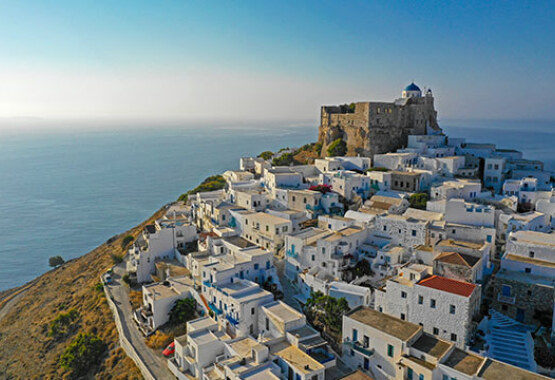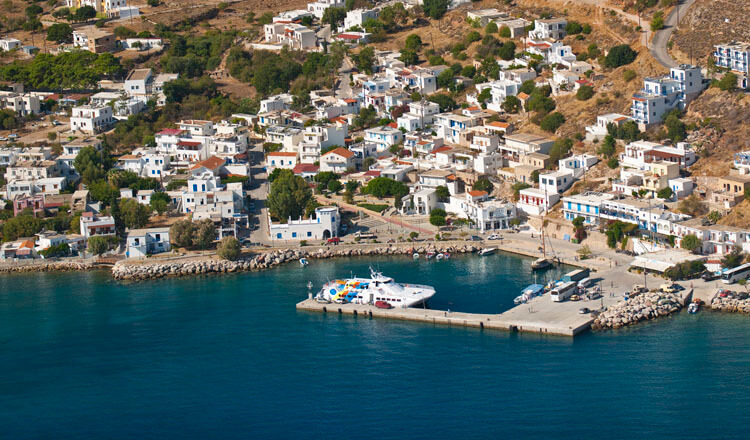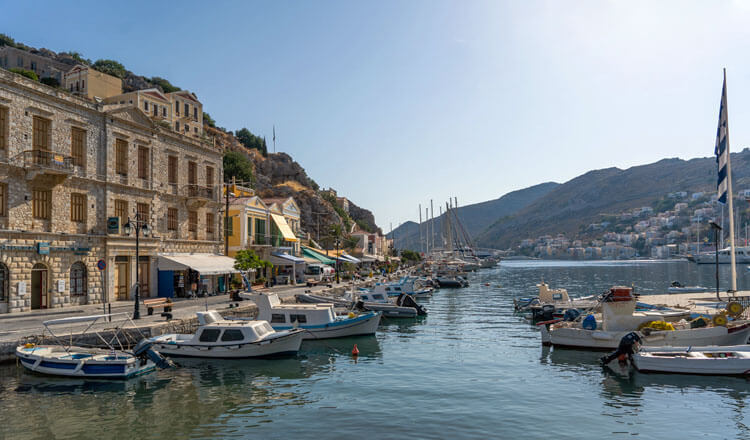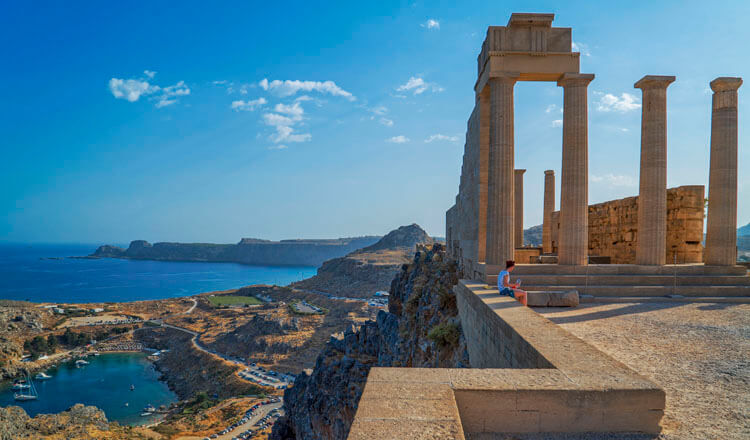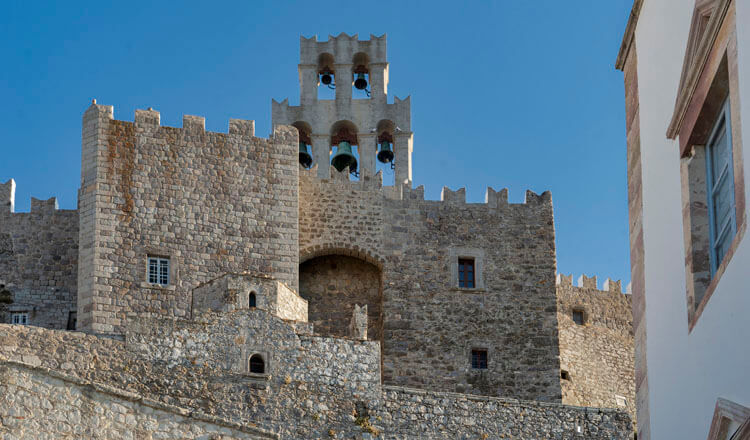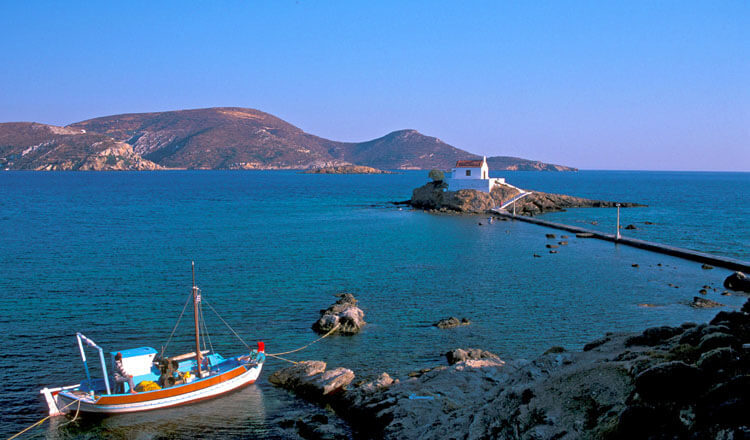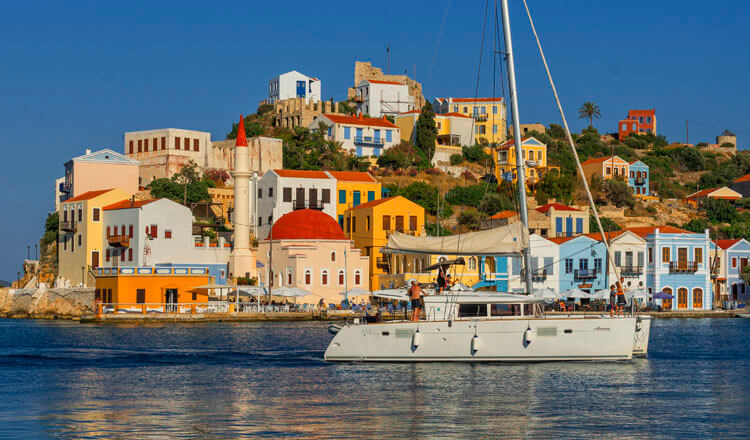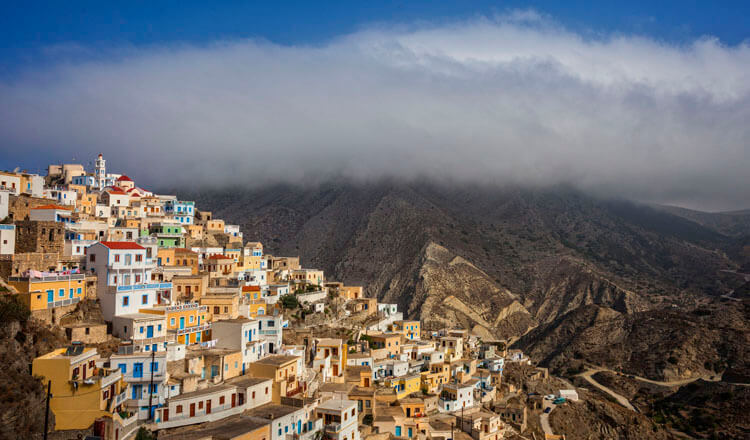As you approach Chalki’s natural harbour you will be impressed by the picture-perfect and colourful Nimporio (or Emporeio)- the island’s only town, built by the harbour and up the hillside. There are few cars on Chalki, but you probably won’t need them, as distances are short. Go for a stroll along the town’s picturesque little alleys; you’ll pass by the neoclassical stone-built two or three-storey houses that possess the most amazing of yards: their floor is paved with chochlakia i.e. black and white pebbles arranged in impressive mosaic patterns. The coloured walls and roof tops add to the locale’s magic. The 19th c. Town Hall is a neoclassical white building that stands by the imposing stone-built Clock Tower. At a short distance you will see the grand belfry of the 1861 church of Agios Nikolaos (St. Nicholas, the island’s patron saint). Inside the church you will see some amazing murals and a wood-carved icon screen of great artistry. Visit also the small ecclesiastical museum housed in the church. The Traditional House of Chalki (the Folk Art Museum) will offer you a comprehensive view of the local folk art heritage through the display of furniture, embroideries, cooking utensils and other household items. Nimporio has been named a Heritage Town.
Walk up the hill towards Chorio, the island’s deserted medieval village which was inhabited until c. 1870. Later, the locals gradually settled by the harbour as in the late 19th c. piracy ceased to be a threat for them.
Follow the trail from Panagia Church [Virgin Mary] in Chorio to the top of the hill. From that location, the panoramic view is breathtaking: you’ll be able to see all the way to the shores of Rhodes Island. This is where the remains of the Castle of the Knights stand, overlooking the entire area. It is a 14th c. edifice, built by the Knights of the Order of St. John, when they took possession of the island. At the castle gates you will see the coat of arms of Pierre d’ Aubusson, the Grand Master of the Order at that time. Inside the castle, visit the deserted church of Agios Nicholaos (St. Nicholas) where you will see the amazing 15th – 17th c. murals.
The Windmills of Chalki is a sight not to be missed, situated, too, on the hilltop. As they are an important part of the island’s history, they have been renovated, but they are not in working order anymore.
There are many churches, country chapels and monasteries you can visit on Chalki Island. Panagia Choriani church should definitely be on your list as there are incredible murals inside it. The views from that location are impressive, too.
The Monastery of Archangel Michael Panormitis is on Agios Onoufrios Hill, surrounded by trees, 5km NW of Emporeio. The monastery church and yard floor is a work of art, typical of the traditional Dodecanese style: the beautiful geometric or nature-inspired mosaic patterns were made with black and white chochlakia (pebbles of equal size). Inside the church you will see 19th c. icons and votive offerings. You can also visit a Byzantine chapel with great 13th and 14th c. murals, nearby. The bird’s eye view from the spot will make you catch your breath as the blue Aegean Sea waters below are dotted with islets and rocks of various sizes.
The Monastery of St. John Alargas (7.5 km W) wears the colours of the Aegean Sea: the dome and the walls are dressed in blue and white respectively. The huge tree in the middle of the monastery yard will offer you shade and a place to rest. The elevated position offers attractive views. If you’re interested, there is a bus you can take from Nimporio to the monastery.
Beaches – water sports
On Chalki Island, there are sandy and pebbly shores, just pick the ones that suit your taste. You can reach them by bus, car or by boat if there’s no access by road. If you’re a family with small children, the ideal beach for you would be Pontamos beach (SE) because the waters are shallow and the sand is fine and white. To the North, you can visit Areta, Agios Georgios, Dyo Gyaloi, and Pyrgos; these are beautiful pebbly beaches you can access by boat. Take a trip also to Kania (E) and Ftenagia (SE) beaches. To the South, visit pebbly Giali beach and Tracheia peninsula where you will discover two lovely beaches one pebbly and one sandy that form a stretch of land similar to the neck of a bottle. You can walk from one to the other in a couple of minutes.
For the diving fans among you, there is a diving school where you can get the gear you need or take lessons by an experienced trainer. You will be amazed at the incredible clarity of the waters around Chalki, which remain transparent up to a 40-metre depth. Explore the seabed, the underwater caves, and the shipwrecks in the area, and enjoy the activities on offer for children and grownups. You can also board one of the local boats that offer day trips to the islets east of Chalki or take your private boat and explore the pristine waters of the area.
Events
The Chalki Festival takes place each September, during the first two weeks of the month, in connection with Chalki being named the “Peace & Friendship Island”. International activities and seminars are included in the programme and high numbers of young visitors attend the events.
Feasts on the island follow the religious celebrations. On August 15th go to the Panagia Choriani feast, and you’ll enjoy good food, music and dancing. On August 29th join the feast that takes place in Agios Ioannis (St. John) Alargas monastery, and on November 8th visit the monastery of Archangel Michael Panormitis where pilgrims/visitors gather next to local lyra players for the festivities.
Flavour
Chalki’s food products are both tasty and top quality. Try the excellent local thyme honey, the soft cheese made with goat and sheep milk in the traditional way, mellow prickly pears, hand-made makarounia (stripes of pasta) and koulia (sea shell-shaped pasta), lamb or goat kid ofto (=stuffed) baked in a wood-fired oven (the most “festive” of local meals), the tiny delicious giaprakia (vine leaves stuffed with minced meat and herbs), fresh fish (taste fried Mediterranean parrotfish, kakavia soup, and the local tiny red shrimps that you will eat hot off the frying pan).
And don’t forget to ask for a glass of refreshing and flavourful souma drink. Cheers!
